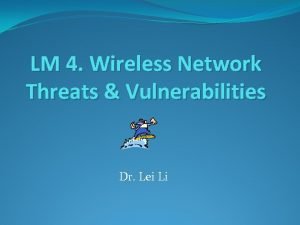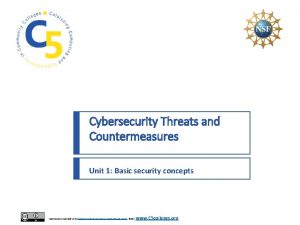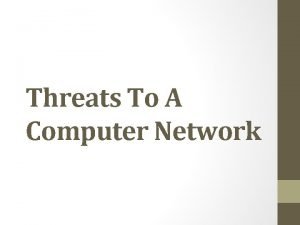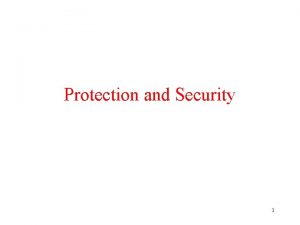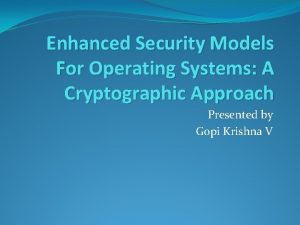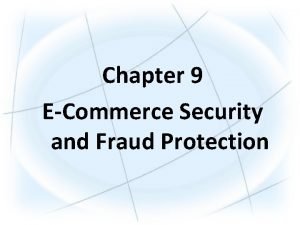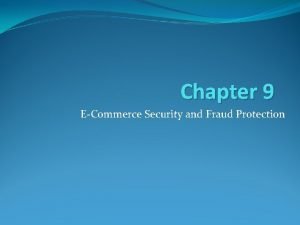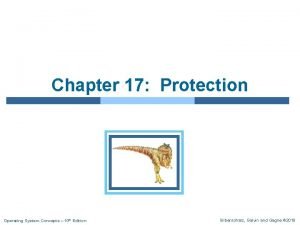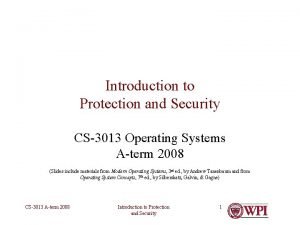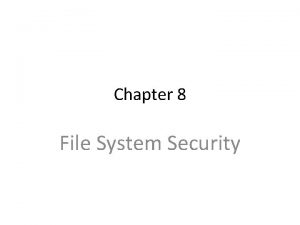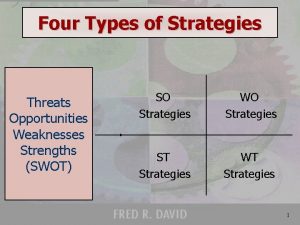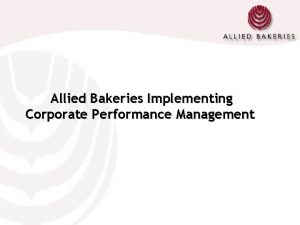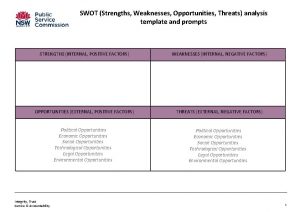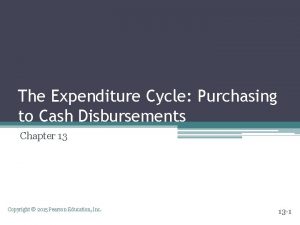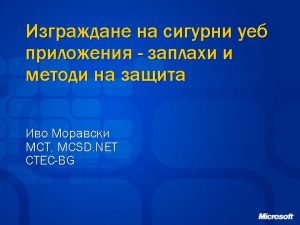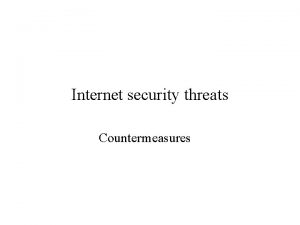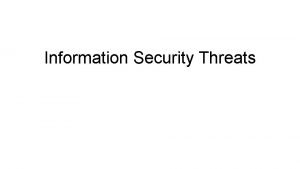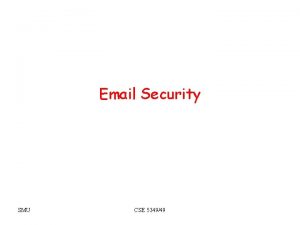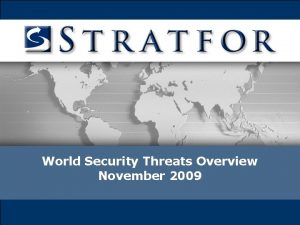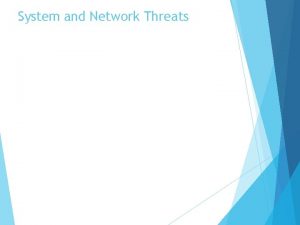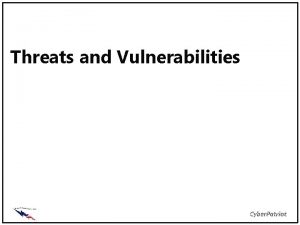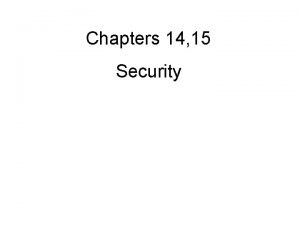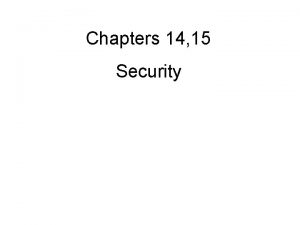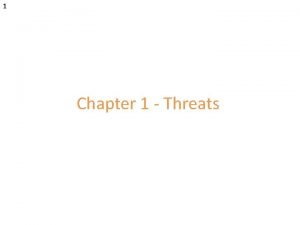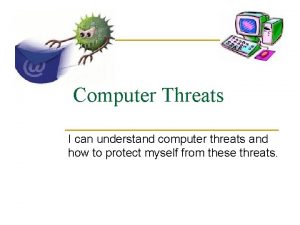Security and Protection The Security Environment Threats Security
























- Slides: 24

Security and Protection

The Security Environment Threats Security goals and threats

Basics of Cryptography Relationship between the plaintext and the ciphertext

Secret-Key Cryptography • Monoalphabetic substitution – each letter replaced by different letter • Given the encryption key, – easy to find decryption key • Secret-key crypto called symmetric-key crypto

Public-Key Cryptography • All users pick a public key/private key pair – publish the public key – private key not published • Public key is the encryption key – private key is the decryption key

RSA Encryption To find a key pair e, d: 1. Choose two large prime numbers, P and Q (each greater than 10100), and form: N=Px. Q Z = (P– 1) x (Q– 1) 2. For d choose any number that is relatively prime with Z (that is, such that d has no common factors with Z). We illustrate the computations involved using small integer values for P and Q: P = 13, Q = 17 –> N = 221, Z = 192 d=5 3. To find e solve the equation: e x d = 1 mod Z That is, e x d is the smallest element divisible by d in the series Z+1, 2 Z+1, 3 Z+1, . . e x d = 1 mod 192 = 1, 193, 385, . . . 385 is divisible by d e = 385/5 = 77

RSA Encryption (contd. ) To encrypt text using the RSA method, the plaintext is divided into equal blocks of length k bits where 2 k < N (that is, such that the numerical value of a block is always less than N; in practical applications, k is usually in the range 512 to 1024). k = 7, since 27 = 128 The function for encrypting a single block of plaintext M is: (N = P X Q = 13 X 17 = 221), e = 77, d = 5: E'(e, N, M) = Me mod N for a message M, the ciphertext is M 77 mod 221 The function for decrypting a block of encrypted text c to produce the original plaintext block is: D'(d, N, c) = cd mod N The two parameters e, N can be regarded as a key for the encryption function, and similarly d, N represent a key for the decryption function. So we can write Ke = <e, N> and Kd = <d, N>, and we get the encryption function: E(Ke, M) ={M}K (the notation here indicating that the encrypted message can be decrypted only by the holder of the private key Kd) and D(Kd, ={M}K ) = M. <e, N> - public key, d – private key for a station

Application of RSA • Lets say a person in Atlanta wants to send a message M to a person in Buffalo: • Atlanta encrypts message using Buffalo’s public key B E(M, B) • Only Buffalo can read it using it private key b: E(b, E(M, B)) M • In other words for any public/private key pair determined as previously shown, the encrypting function holds two properties: – E(p, E(M, P)) M – E(P, E(M, p)) M

How can you authenticate “sender”? • In real life you will use signatures: we will look at concept of digital signatures next. • Instead of sending just a simple message, Atlanta will send a signed message signed by Atlanta’s private key: – E(B, E(M, a)) • Buffalo will first decrypt using its private key and use Atlanta’s public key to decrypt the signed message: – E(b, E(B, E(M, a)) E(M, a) – E(A, E(M, a)) M

Digital Signatures • Strong digital signatures are essential requirements of a secure system. These are needed to verify that a document is: • Authentic : source • Not forged : not fake • Non-repudiable : The signer cannot credibly deny that the document was signed by them.

Digest Functions • Are functions generated to serve a signatures. Also called secure hash functions. • It is message dependent. • Only the Digest is encrypted using the private key.

Alice’s bank account certificate 1. Certificate type : 2. Name: 3. Account: 4. Certifying authority : 5. Signature: Account number Alice 6262626 Bob’s Bank {Digest(field 2 + field 3) }K bpr iv

Digital signatures with public keys

Low-cost signatures with a shared secret key

One-Way Functions • Function such that given formula for f(x) – easy to evaluate y = f(x) • But given y – computationally infeasible to find x

Digital Signatures (b) • Computing a signature block • What the receiver gets

Protection Mechanisms Protection Domains (1) Examples of three protection domains

Protection Domains (2) A protection matrix

Protection Domains (3) A protection matrix with domains as objects

Access Control Lists (1) Use of access control lists of manage file access

Access Control Lists (2) Two access control lists

Capabilities (1) Each process has a capability list

Capabilities (2) • Cryptographically-protected capability Server • Object Rights Generic Rights 1. 2. 3. 4. Copy capability Copy object Remove capability Destroy object f(Objects, Rights, Check)

Summary • We studied fundamental concepts in security and protection. • If you are interested in this topic you can pursue a graduate degree on this topic.
 Wireless security threats and vulnerabilities
Wireless security threats and vulnerabilities Cyber security threats and countermeasures
Cyber security threats and countermeasures Careful protection and preservation of environment
Careful protection and preservation of environment Modern network security threats
Modern network security threats Communication channel threats
Communication channel threats Wireless security threats
Wireless security threats Most common computer security threats
Most common computer security threats Financial environment of business
Financial environment of business Security and protection in operating system
Security and protection in operating system Security and protection in operating system
Security and protection in operating system E commerce security and fraud protection
E commerce security and fraud protection E-commerce security and fraud protection
E-commerce security and fraud protection Security and protection in operating system
Security and protection in operating system Protection and security in operating system
Protection and security in operating system File protection and security
File protection and security Explain four types of strategies in “swot matrix”
Explain four types of strategies in “swot matrix” Malicious attacks threats and vulnerabilities
Malicious attacks threats and vulnerabilities Factbranch
Factbranch Swot analysis of a teacher
Swot analysis of a teacher Cos swot analysis
Cos swot analysis Media information opportunities and challenges
Media information opportunities and challenges Strengths opportunities threats weaknesses
Strengths opportunities threats weaknesses Virus and related threats
Virus and related threats 4 basic expenditure cycle activities
4 basic expenditure cycle activities Opportunities and threats of a person
Opportunities and threats of a person
